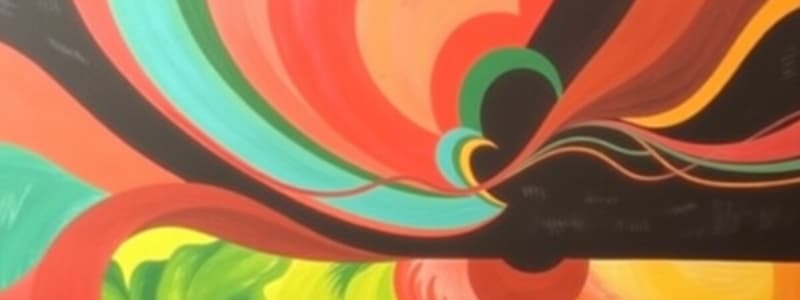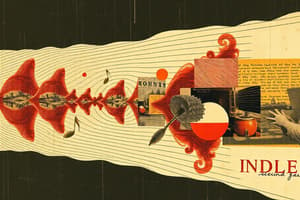Podcast
Questions and Answers
In the context of sound, what process describes sound waves passing from one medium to another, leading to a change in their direction and speed?
In the context of sound, what process describes sound waves passing from one medium to another, leading to a change in their direction and speed?
- Absorption
- Refraction
- Diffraction (correct)
- Reflection
Which term refers to dynamics, articulation, and tempo markings in a musical score, indicating how a piece should be played?
Which term refers to dynamics, articulation, and tempo markings in a musical score, indicating how a piece should be played?
- Coupling
- Soundscape (correct)
- Resonance
- Soundmarks
What creates the illusion of a sound originating from a location between two speakers?
What creates the illusion of a sound originating from a location between two speakers?
- Phantom image
- Soundscape (correct)
- Resonance
- Sound-Medium Interface
What is the primary function of a resonator in the context of musical instruments?
What is the primary function of a resonator in the context of musical instruments?
Which concept describes the auditory environment created by the combination of various sounds?
Which concept describes the auditory environment created by the combination of various sounds?
What is the term for the transmission of sound vibrations through the bones of the skull to the inner ear?
What is the term for the transmission of sound vibrations through the bones of the skull to the inner ear?
How does 'balance' differ from 'panning' in audio mixing?
How does 'balance' differ from 'panning' in audio mixing?
What process converts one form of energy into another, especially in the context of sound recording and reproduction?
What process converts one form of energy into another, especially in the context of sound recording and reproduction?
Which of the following best describes the function of 'coupling' in sound production?
Which of the following best describes the function of 'coupling' in sound production?
Which of the following is true of pink noise?
Which of the following is true of pink noise?
Flashcards
Soundscape
Soundscape
The overall auditory environment created by combining different sounds.
Sound propagation
Sound propagation
The transmission of sound waves through different mediums such as air and water.
Resonator
Resonator
Amplifying sounds in a musical instrument.
Resonance
Resonance
Signup and view all the flashcards
Soundmarks
Soundmarks
Signup and view all the flashcards
Sound-Medium Interface
Sound-Medium Interface
Signup and view all the flashcards
Reflection
Reflection
Signup and view all the flashcards
Refraction
Refraction
Signup and view all the flashcards
Diffraction
Diffraction
Signup and view all the flashcards
Just Noticeable Difference (JND)
Just Noticeable Difference (JND)
Signup and view all the flashcards
Study Notes
- Soundscape is the complete auditory environment resulting from the combination of various sounds.
- Radiation is the application of electromagnetic radiation in sound creation.
- Sound propagation is the process where sound waves travel through media like air and water.
- Forced vibration is the motion of a vibrating system caused by external forces.
- Coupling involves connecting registers as well as enriching melodies or chords to produce a full sound.
- A resonator is a device used to amplify sound in musical instruments.
- Resonance occurs when sound waves amplify each other, or when an object vibrates due to sound waves.
- Bone conduction is the transmission of sound vibrations through skull bones directly to the inner ear.
- Soundmarks are the dynamics, articulation, and tempo markings in music that guide performance.
- The sound-medium interface involves the interaction between sound waves and the medium they travel through.
- Reflection is when sound waves bounce off a surface or boundary.
- Refraction occurs when sound waves change speed and direction as they pass from one medium to another.
- Diffraction is the bending of sound waves around obstacles or through openings.
- Absorption happens when sound waves lose energy as they pass through a medium, often turning into heat.
- Transmission is when sound waves pass through a medium without significant loss due to absorption or reflection.
- Just Noticeable Difference (JND) refers to the smallest detectable change in frequency or loudness.
- Equal loudness contours illustrate how loud sounds at different frequencies need to be to be perceived equally loud.
- Panning is moving a sound within the stereo field.
- A phantom image is a psychoacoustic effect that creates the illusion of sound originating between speakers.
- In Logic, "panning" moves a sound across the stereo field.
- "Balance" adjusts the volume between left and right channels.
- Alan Blumlein was a British engineer who invented a stereo recording technique.
- The 5 types of stimulus/response (S/R) include: Reflexive, Conditioned, Operant, Voluntary and Sensory
- Pitch depends on frequency that determine how high or low a sound is.
- An inharmonic spectrum includes frequencies with inharmonic partials, which are overtones that don't match an ideal harmonic.
- The fundamental is the lowest pitch of a note.
- Psychoacoustics is the study of how humans perceive sound.
- Transduction is converting one type of energy into another.
- Fidelity is how accurately a recording reproduces the original sound.
- White noise distributes all frequencies equally, creating a harsh and high-pitched sound.
- Pink noise has more power at lower frequencies, creating a deeper, softer sound.
- A logarithmic scale measures musical intervals and pitch, using logarithms to represent ratios of frequencies.
- The digital audio chain is the path an audio signal takes from recording to the listener's ears.
- Nyquist frequency is the highest frequency that can be accurately digitized from an analog signal.
- Amplitude modulation is a technique that alters the loudness of a sound, often periodically.
- Hyperrealism is a compositional style using environmental sounds in exaggerated ways.
- Radiophonics is the use of electronic means to create sounds for radio or television.
Studying That Suits You
Use AI to generate personalized quizzes and flashcards to suit your learning preferences.
Related Documents
Description
Explore acoustics through soundscape definitions, radiation's role in sound creation, and sound wave propagation in diverse media, while understanding forced vibration and coupling in sound production. Discover sound amplification with resonators, resonance phenomena, bone conduction mechanisms, soundmarks in music, interaction at the sound-medium interface, and sound wave reflections.




